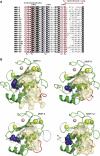Towards third generation matrix metalloproteinase inhibitors for cancer therapy
- PMID: 16538215
- PMCID: PMC2361222
- DOI: 10.1038/sj.bjc.6603043
Towards third generation matrix metalloproteinase inhibitors for cancer therapy
Abstract
The failure of matrix metalloproteinase (MMP) inhibitor drug clinical trials in cancer was partly due to the inadvertent inhibition of MMP antitargets that counterbalanced the benefits of MMP target inhibition. We explore how MMP inhibitor drugs might be developed to achieve potent selectivity for validated MMP targets yet therapeutically spare MMP antitargets that are critical in host protection.
Figures


Similar articles
-
Mechanisms to inhibit matrix metalloproteinase activity: where are we in the development of clinically relevant inhibitors?Recent Pat Anticancer Drug Discov. 2007 Jun;2(2):135-42. doi: 10.2174/157489207780832423. Recent Pat Anticancer Drug Discov. 2007. PMID: 18221058 Review.
-
Matrix metalloproteinase inhibitors.Curr Oncol Rep. 2004 Mar;6(2):96-102. doi: 10.1007/s11912-004-0020-7. Curr Oncol Rep. 2004. PMID: 14751086 Review.
-
Tumour microenvironment - opinion: validating matrix metalloproteinases as drug targets and anti-targets for cancer therapy.Nat Rev Cancer. 2006 Mar;6(3):227-39. doi: 10.1038/nrc1821. Nat Rev Cancer. 2006. PMID: 16498445 Review.
-
Development of matrix metalloproteinase inhibitors in cancer therapy.J Natl Cancer Inst. 2001 Feb 7;93(3):178-93. doi: 10.1093/jnci/93.3.178. J Natl Cancer Inst. 2001. PMID: 11158186 Review.
-
Induction of tumour cell apoptosis by matrix metalloproteinase inhibitors: new tricks from a (not so) old drug.Expert Opin Investig Drugs. 2001 Jun;10(6):1075-84. doi: 10.1517/13543784.10.6.1075. Expert Opin Investig Drugs. 2001. PMID: 11772236 Review.
Cited by
-
Simple pseudo-dipeptides with a P2' glutamate: a novel inhibitor family of matrix metalloproteases and other metzincins.J Biol Chem. 2012 Aug 3;287(32):26647-56. doi: 10.1074/jbc.M112.380782. Epub 2012 Jun 11. J Biol Chem. 2012. PMID: 22689580 Free PMC article.
-
Molecular mechanism of pancreatic tumor metastasis inhibition by Gd@C82(OH)22 and its implication for de novo design of nanomedicine.Proc Natl Acad Sci U S A. 2012 Sep 18;109(38):15431-6. doi: 10.1073/pnas.1204600109. Epub 2012 Sep 4. Proc Natl Acad Sci U S A. 2012. PMID: 22949663 Free PMC article.
-
Mechanism-based profiling of MMPs.Methods Mol Biol. 2010;622:471-87. doi: 10.1007/978-1-60327-299-5_27. Methods Mol Biol. 2010. PMID: 20135299 Free PMC article. Review.
-
Active site ring-opening of a thiirane moiety and picomolar inhibition of gelatinases.Chem Biol Drug Des. 2009 Dec;74(6):527-34. doi: 10.1111/j.1747-0285.2009.00881.x. Epub 2009 Oct 6. Chem Biol Drug Des. 2009. PMID: 19807733 Free PMC article.
-
Matrix metalloproteinases: protective roles in cancer.J Cell Mol Med. 2011 Jun;15(6):1254-65. doi: 10.1111/j.1582-4934.2011.01302.x. J Cell Mol Med. 2011. PMID: 21418514 Free PMC article. Review.
References
-
- Butler G, Overall CM (2006) Proteases as drug targets. Pharmacoproteomics for protease drug target validation of matrix metalloproteinase inhibitor drugs using isotope-coded affinity tags. Curr Pharm Design in press - PubMed
-
- Castelhano AL, Billedeau R, Dewdney N, Donnelly S, Horne S, Kurz LJ, Liak TJ, Martin R, Uppington R, Yuan Z, Krantz A (1995) Novel indolactam-based inhibitors of matrix metalloproteinases. Bioorganic Med Chem Lett 5: 1415–1420
-
- Chen JM, Nelson FC, Levin JI, Mobilio D, Moy FJ, Nilakantan R, Zask A, Powers R (2000) Structure-based design of a novel, potent, and selective inhibitor for MMP-13 utilizing NMR spectroscopy and computer-aided molecular design. J Am Chem Soc 122: 9648–9654
Publication types
MeSH terms
Substances
LinkOut - more resources
Full Text Sources
Other Literature Sources

